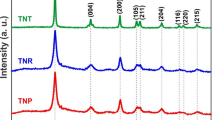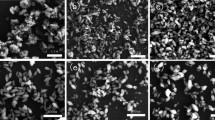Abstract
Dye-sensitized solar cells (DSSCs) based on TiO2 nanostructures have attracted much attention due to their high photoconversion efficiency. Here, we report the hydrothermal synthesis of surfactant-mediated TiO2 material to fabricate efficient DSSC. The influence of surfactants such as ethylenediaminetetraacetic acid, cetyltrimethylammonium bromide, and sodium dodecyl sulfate on the photovoltaic performance of DSSC was studied. The FESEM images indicated that the vertically aligned TiO2 nanorods were uniformly grown on the fluorine-doped tin oxide (FTO) glass substrates. The sodium dodecyl sulfate-mediated TiO2 shows the formation of microflowers on the surface of vertically aligned nanorods. The effects of surfactant on the solar cell parameters, i.e. open-circuit potential, short-circuit current density, and photoconversion efficiency were studied. The significant improvement in photoconversion efficiency was observed to be 8.30% for the sodium dodecyl sulfate-mediated TiO2 photoanode.










Similar content being viewed by others
References
Regan BO, Gratzel MJ (1994) A low-cost, high-efficiency solar cell based on dye-sensitized colloidal TiO2 films. Nature 353:737–740
Gratzel MJ (2003) Dye-sensitized solar cell. J Photochem Photobiol C 4(2):145–153
Roh SJ, Mane RS, Min SK, Lee WJ, Lokhande CD, Han SH (2006) Achievement of 4.51% conversion efficiency using ZnO recombination barrier layer in TiO2 based dye-sensitized solar cells. Appl Phys Lett 89(25):253512
Wang X, Xiang Y, Zhou B, Zhang Y, Wu J, Hu R, Liu L, Song J, Qu J (2019) Enhanced photocatalytic performance of Ag/TiO2 nanohybrid sensitized by black phosphorus nanosheets in visible and near-infrared light. J Colloid Interface Sci 534:1–11
Prasannalakshmi P, Shanmugam N, Kumar S (2017) Electrochemistry of TiO2/CdS composite electrodes for supercapacitor applications. J Appl Electrochem 47(8):889–903
Mane RS, Lee WJ, Pathan HM, Han SH (2005) Nanocrystalline TiO2/ZnO thin films: fabrication and application to dye-sensitized solar cells. J Phys Chem B 109(51):24254–24259
Gorduk S, Avciata O, Avciata U (2017) Photocatalytic degradation of methylene blue under visible light irradiation by non-peripherally tetra substituted phthalocyanine-TiO2 nanocomposites. Inorganica Chim Acta 471:137–147
Avciata O, Sahin F, Erden I, Avciata U (2010) Hydrothermal preparation and characterization of nanocrystalline TiO2 powder and its photocatalytic degradation of alizarin salt dye under UV-light. Asian J Chem 4:2953–2958
Avciata O, Benli Y, Gorduk S, Koyun O (2016) Ag doped TiO2 nanoparticles prepared by hydrothermal method and coating of the nanoparticles on the ceramic pellets for photocatalytic study: surface properties and photoactivity. J Eng Technol Appl Sci 1:34–50
Iraj M, Nayeri FD, Asl-Soleimani E, Narimani K (2015) Controlled growth of vertically aligned TiO2 nanorod arrays using the improved hydrothermal method and their application to dye-sensitized solar cells. J Alloy Comd 659:44–50
Jeyaraman AR, Balasingam SK, Lee C, Lee H, Balakrishnan B, Manickam S, Yi M, Kim HJ, Nallathambi KS, Jun Y, Kuzhandaivel H (2019) Enhanced solar to electrical energy conversion of titania nanoparticles and nanotubes-based combined photoanodes for dye-sensitized solar cells. Mater Lett 243:180–182
Navale ST, Tehare KK, Shaikh SF, Patil VB, Pawar BN, Naushad Mu, Stadler FJ, Mane RS (2016) Hexamethylenetetramine-mediated TiO2 films: Facile chemical synthesis strategy and their use in nitrogen dioxide detection. Mat Lett 173:9-12
Shinde PS, Bhosale CH (2008) Properties of chemical vapour deposited nanocrystalline TiO2 thin films and their use in dye-sensitized solar cells. J Anal Appl Pyrolysis 82(1):83–88
Burungale VV, Satale VV, Teli AM, Kamble AS, Kim JH, Patil PS (2016) Surfactant-free single step synthesis of TiO2 3D microflowers by hydrothermal route and its photoelectrochemical characterizations. J Alloy Compd 656:491–499
Ghoderao KP, Jamble SN, Kale RB (2018) Influence of reaction temperature on hydrothermally grown TiO2 nanorods and their performance in dye-sensitized solar cells. Superlattice Microst 124:121–130
John MA, Ramamurthia K, Sethuramanb K, Babu RR (2017) Morphologically tuned 3D/1D rutile TiO2 hierarchical hybrid microarchitectures engineered by one-step surfactant free hydrothermal method. Appl Surf Sci 405:195–204
Shi J, Wang X (2011) Growth of rutile titanium dioxide nanowires by pulsed chemical vapor deposition. Cryst Growth Des 11(4):949–954
Mayabadi AH, Waman VS, Kamble MM, Ghosh SS, Gabhale BB, Rondiya SR, Rokade AV, Khadtare SS, Sathe VG, Pathan HM, Gosavi SW, Jadkar SR (2014) Evolution of structural and optical properties of rutile TiO2 thin films synthesized at room temperature by chemical bath deposition method. J Phys Chem Solids 75(2):182–187
Mayabadi AH, Pawbake A, Rondiya S, Rokade A, Waykar R, Jadhavar A, Date A, Sharma V, Prasad M, Pathan HM, Jadkar SR (2016) Synthesis, characterization, and photovoltaic properties of TiO2/CdTe core-shell heterostructure for semiconductor-sensitized solar cells (SSSCs). J Solid State Electrochem 21:2665–2676
Attar AS, Mirdamadi S, Hajiesmaeilbaigi F, Ghamsari M (2007) Growth of TiO2 nanorods by sol-gel template process. J Mater Sci Technol 23:611–613
Meng L, Ren T, Li C (2010) The control of the diameter of the nanorods prepared by dc reactive magnetron sputtering and the applications for DSSC. Appl Surf Sci 256(11):3676–3682
Pawar SA, Patil DS, Pawar UT, Devan RS, Karanjkar MM, Ma YR, Shin SW, Kim JH, Patil PS (2015) Photoelectrochemical solar cell based on surfactant mediated rutile TiO2 nanorods. J Mater Sci Mater Electron 26:2595–2604
Mali SS, Betty CA, Bhosale PN, Devan RS, Ma YR, Kolekar SS, Patil PS (2012) Hydrothermal synthesis of rutile TiO2 nanoflowers using Brønsted Acidic Ionic Liquid [BAIL]: synthesis, characterization and growth mechanism. Cryst Eng Comm 14(6):1920–1924
Manne S, Cleveland JP, Gaub HE, Stucky GD, Hansma PK (1994) Direct visualization of surfactant hemimicelles by force microscopy of the electrical double layer. Langmuir 10(12):4409–4413
Retter U, Tchachnikova M (2003) On the formation of surface micelles at the metal ∣ electrolyte interface. J Electroanal Chem 550:201–208
Shirani A, Momenzadeh M, Sanjabi S (2012) Surfactant effect on the electrochemical behavior of Co–TiO2 nanocomposite coatings. Surf Coat Technol 206(11-12):2870–2876
Patil PB, Mali SS, Kondalkar VV, Pawar NB, Khot KV, Hong CK, Patil PS, Bhosale PN (2014) Single-step hydrothermal synthesis of hierarchical TiO2 microflowers with radially assembled nanorods for enhanced photovoltaic performance. RSC Adv 4(88):47278–47286
Kondalkar VV, Mali SS, Pawar NB, Mane RM, Choudhury S, Hong CK, Patil PS, Patil SR, Bhosale PN (2014) Microwave-assisted rapid synthesis of highly porous TiO2 thin films with nanocrystalline framework for efficient photoelectrochemical conversion. Electrochim Acta 143:89–97
Lee SM, Chao SN, Cheon JW (2003) Anisotropic shape control of colloidal inorganic nanocrystals. Adv Mater 15(5):441–444
Bhat TS, Devan RS, Mali SS, Kamble AS, Pawar SA, Kim IY, Ma YR, Hong CK, Kim JH, Patil PS (2014) Photoelectrochemically active surfactant free single step hydrothermal mediated titanium dioxide nanorods. J Mater Sci Mater Electron 25:4501–4511
Chen HS, Su C, Chen JL, Yang TY, Hsu NM, Li WR (2010) Preparation and characterization of pure rutile TiO2 nanoparticles for photocatalytic study and thin films for dye-sensitized solar cells. J Nanomater 2011: Article ID 869618, 8 pages
Byun HY, Vittal R, Kim DY, Kim KJ (2004) Beneficial role of cetyltrimethylammonium bromide in the enhancement of photovoltaic properties of dye-sensitized rutile TiO2 solar cells. 20:6853–6857
Biswas A, Corani A, Kathiravan A, Infahsaeng Y, Yartsev A, Sundstrom V, De S (2013) Control of the size and shape of TiO2 nanoparticles in restricted media. 24: 195601
Dennis Christy P, Melikechi N, Nirmala Jothi NS, Baby Suganthi AR, Sagayaraj P (2010) Synthesis of TiO2 nanorods by oriented attachment using EDTA modifier: a novel approach towards 1D nanostructure development. J Nanopart Res 12(8):2875–2882
Wang D, Choi D, Yang Z, Viswanathan VV, Nie Z, Wang C, Song Y, Zhang JG, Liu J (2008) Synthesis and Li-ion insertion properties of highly crystalline mesoporous rutile TiO2. Chem Mat 20(10):3435–3442
Zhou W, Liu X, Cui J, Liu D, Li J, Jiang H, Wang J, Liu H (2011) Control synthesis of rutile TiO2 microspheres, nanoflowers, nanotrees and nanobelts via acid-hydrothermal method and their optical properties. Cryst Eng Comm 13(14):4557–4563
Acknowledgments
The authors acknowledge the Department of Science and Technology (DST), India under the DST-FIST (SR/FST/PSI-173/2012) program. They are also thankful to the INUP program, IIT Bombay, India, for the utilization of characterization facilities such as FESEM, XPS, and HRTEM.
Author information
Authors and Affiliations
Corresponding author
Additional information
Publisher’s note
Springer Nature remains neutral with regard to jurisdictional claims in published maps and institutional affiliations.
Rights and permissions
About this article
Cite this article
Ghoderao, K.P., Jamble, S.N. & Kale, R.B. Efficient dye-sensitized solar cells based on surfactant-mediated TiO2 nanostructures. J Solid State Electrochem 23, 1685–1695 (2019). https://doi.org/10.1007/s10008-019-04271-z
Received:
Revised:
Accepted:
Published:
Issue Date:
DOI: https://doi.org/10.1007/s10008-019-04271-z




